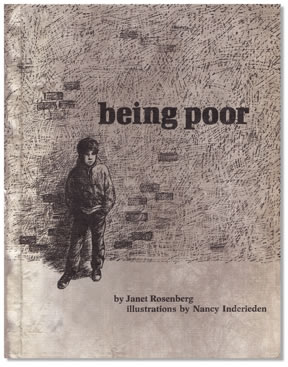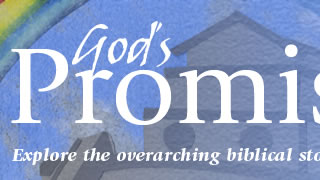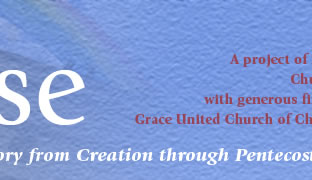 Annunciation to Mary
Annunciation to Mary
 “Being Poor”
“Being Poor”
“Being Poor” is a story about some of the people Mary sings about—those who do not have enough. The story will help us think and talk about what it is like to be poor. Read “Being Poor” by Janet Rosenberg. Suggest to the children that they pay special attention to the people’s faces in the book.
Are the people happy or sad or worried? How can you tell from their faces?
After you have read the story, consider the following questions:
- Where did you see happy people or sad people or worried people in this book? How could you tell?
- How many blankets do you have on your bed at home? Do you have enough?
- What is it like or would it be like to not get any Christmas presents?
- Why do you think some people are poor while others are not?
- God loves all people because all people belong to God. How do you imagine God feels when people are hungry?
Pearls by Sade
The student resource for older students explores the realities of hunger and poverty. The pages contain three pieces of poetry or lyrics to which students are invited to react: a poem written by an Indian author, a poem pondering why hunger exists, and song lyrics that explore the experience of desperate poverty. There is much about the actual experience of poverty and hunger that is beyond the reality of most American teens. These pieces prod the students to consider a reality perhaps far from their own.
The Arithmetic of Poverty
Before the students turn to page 10, ask them to listen carefully while an adult reads The Arithmetic of Poverty. After reading the poem, ask the students to turn to page 10 where it is printed. Consider the following tensions represented in this section:
- If you were this mother, who/what would you hate? Would your hatred be justified? How so or how not?
- Think about the poem’s title. How does it relate to the poem itself?
- If you were naming the poem, what other title would you choose?
How Come?
Read through How come? on page 10. Consider the following matters captured in this poem:
- What questions have you asked or wondered about that are similar to these?
- How would you go about responding to the questions in this poem?
- Authors usually write poems for a reason. What might be the author’s reason for writing How Come?
- Discuss what you know about the root causes of hunger.
- Find all the places in this notebook that present angry feelings about hunger. Find all the places in this notebook that suggest hope in the face of hunger.
Pearls
Ask the students to read the lyrics to the song Pearls and then respond to them. The students may record their reflections in the boxes provided on the page. After students have reflected on the song, engage the whole group in a follow-up conversation. Use the interpretive information about the song provided below to help you be prepared for the conversation. The following matters would be worth considering:
- What did you notice when you read through this song?
- What does the song say about the woman’s life? What does the song say about our lives?
- Why “pearls”? Why “brand-new shoes”?
- Something keeps this woman alive. What could it be?
- Why do you imagine the woman says “Hallelujah”? Would the song be different without “Hallelujah”? How so?
- Compare this woman to Sister Judith, whom the group met in the video segment.
- Go online and locate an audio version of Sade singing Pearls.
Information for Leaders: Pearls, Sade
Pearls was composed and performed by Helen Folasade Adu, whose professional name, Sade, is a shortened version of her middle name. Sade is pronounced sha-day. Sade was born in Ibadan, Nigeria, to an English mother and a Nigerian father. She lived in Colchester, Essex (England) from the age of four.
Pearls was written in 1992 to draw attention to the political turmoil, fighting, and starvation that plagued Somalia. The song contemplates a human tragedy that is so complete and horrific it is nearly impossible to describe in words. Many people in the United States live essentially isolated from the kind of desperation experienced by Somalis and many others around the globe. Sade’s Pearls knocks at our doors, making us face the reality known to so many of our brothers and sisters.
This song is quiet, contemplative, perhaps even prayerful. It imagines the struggle of a mother reduced to trying to feed her child by gathering kernels of grain that have fallen along a roadside. For this mother, facing certain starvation, the found grain is nothing short of pearls—gems that represent a modest and fleeting reprieve from the immediacy of starvation.
One of the most humbling points in the song affirms that the woman lives a life she did not choose. Few would choose to live within the shadow of starvation, and even fewer would desire such a life for their children. It is equally important to remember that our lives, too, are not simply the product of our choices. The accidents of birth and forces of history have much to say about people’s lives.
The piece takes a startling turn when the singer, contemplating the woman’s poverty, uses the extraordinarily inadequate comparison that it “hurts like brand-new shoes.” This phrase demonstrates that there is very little in our own lives to compare to the experience of hunger and poverty.
Another quite startling point comes when the word “hallelujah” is repeated twice. The woman seems to have no reason to rejoice, and yet the hallelujahs come. Through the inclusion of this word, a song that was a psalm of lament becomes like a psalm of praise. “Hallelujah” seems to represent a mother who according to all logic should have crossed the threshold into hopelessness, immobility, and utter despair. Yet she holds onto hope for her child’s future. This crazy, illogical, defiant hope is the stuff of Christian faith.











